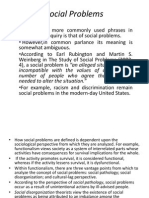0% found this document useful (0 votes)
35 views3 pagesWeek 7 Topic. Social Problems
A social problem is a condition perceived as harmful to society that requires collective action for resolution, characterized by its social origin, widespread impact, and the need for public intervention. Social problems can be classified into various types, including economic, health-related, political, cultural, and environmental issues, and are identified based on societal values and the demand for collective responses. The document emphasizes the importance of sociologists in addressing social problems through identification, explanation, evaluation, and advocacy.
Uploaded by
scottkarim333Copyright
© © All Rights Reserved
We take content rights seriously. If you suspect this is your content, claim it here.
Available Formats
Download as DOCX, PDF, TXT or read online on Scribd
0% found this document useful (0 votes)
35 views3 pagesWeek 7 Topic. Social Problems
A social problem is a condition perceived as harmful to society that requires collective action for resolution, characterized by its social origin, widespread impact, and the need for public intervention. Social problems can be classified into various types, including economic, health-related, political, cultural, and environmental issues, and are identified based on societal values and the demand for collective responses. The document emphasizes the importance of sociologists in addressing social problems through identification, explanation, evaluation, and advocacy.
Uploaded by
scottkarim333Copyright
© © All Rights Reserved
We take content rights seriously. If you suspect this is your content, claim it here.
Available Formats
Download as DOCX, PDF, TXT or read online on Scribd
/ 3
























































































